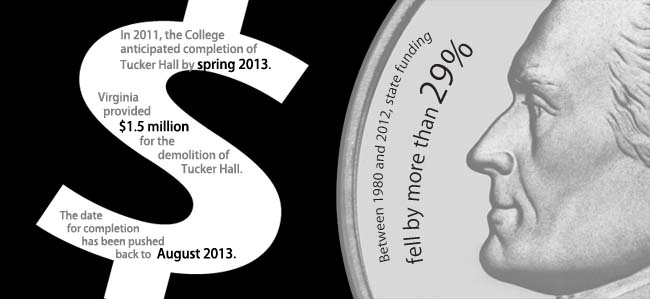If you look at the ongoing construction of the fraternity complex near Yates Hall and the Commons Dining Hall at the College of William and Mary, you will notice that a considerable amount of progress has been made. Conversely, anyone walking past Tucker Hall will find renovations that have taken much longer than initially expected. One significant difference between the two construction projects is that while the College funds the fraternity complex with bonds to be paid back through room fees, it relies on partial funding from the state for the reconstruction of Tucker. To secure state funding for construction, the College must request funds in a long, drawn-out process, frustrated by political tension. Looking to future construction and renovation projects, the College should take note: Projects funded by the state often move less efficiently than projects that are not. While we appreciate the funding the commonwealth of Virginia provides the College for its construction projects, we need to acknowledge that it is not enough and that the difficulty in obtaining funds can hurt or delay the completion of important projects, as seen with Tucker Hall.
In order for the College to take on construction projects and renovate buildings in desperate need of repair, we must look to non-state sources of funding, including self-supporting projects, student philanthropy and alumni donations. The College must make a greater effort to connect alumni with students, not just through organizations like Student Phonathon, but also through more industry-based alumni groups like the Arts and Entertainment Council. The council currently helps students find jobs in their fields but could also be tapped and courted for donations. The College should encourage students and alumni in other fields of study to form similar networks for the dual purposes of career assistance and fundraising for the upkeep, renovation and construction of buildings in their respective lines of work. The Arts and Entertainment Council, for example, could fundraise for the establishment of an arts complex, and alumni in the sciences could donate money and fundraise for the upkeep of Millington Hall and the Integrated Science Center.
We know how expensive college is for families, especially those paying out-of-state tuition, and that many students are borrowing money to pay for it. However, with state funding rapidly becoming scarce and more difficult to obtain, student and parent generosity is essential to maintaining high educational and structural standards. Whether it’s donating some of your own money or participating in fundraising activities, every bit counts.
In the coming years, when Residence Life and Facilities Planning, Design and Construction begins its renovations of Chandler, Landrum, Barrett and Tyler, they should learn from the construction of the fraternity complexes and the renovation of Tucker Hall. State funds can be useful for construction, but the process of acquiring such funding can often impede necessary improvements to the College’s infrastructure. External sources of funding are and will continue to be the better alternative.

































